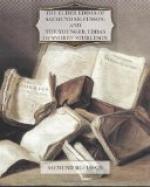32. To the smithy go, which thou hast made, there wilt thou the bellows find with blood besprinkled. The heads I severed of thy boys, and under the prison’s mixen laid their bodies.
33. But their skulls beneath the hair I in silver set, and to Nidud gave; and of their eyes precious stones I formed, which to Nidud’s wily wife I sent.
34. Of the teeth of the two, breast-ornaments I made, and to Bodvild sent. Now Bodvild goes big with child, the only daughter of you both.”
35. “Word didst thou never speak that more afflicted me, or for which I would more severely punish thee. There is no man so tall that he from thy horse can take thee, or so skilful that he can shoot thee down, thence where thou floatest up in the sky.”
36. Laughing Volund rose in air, but Nidud sad remained sitting.
37. “Rise up Thakrad, my best of thralls! bid Bodvild, my fair-browed daughter, in bright attire come, with her sire to speak.
38. Is it, Bodvild! true what has been told to me, that thou and Volund in the isle together sat?”
39. “True it is, Nidud! what has been told to thee, that Volund and I in the isle together sat, in an unlucky hour: would it had never been! I could not against him strive, I might not against him prevail.”
FOOTNOTES:
[Footnote 45: On snow-shoes.]
[Footnote 46: The designation of Alfars’ chief, or prince, applied to Volund, who, as we learn from the prose introduction, was a son of a king of the Finns, may perhaps be accounted for by the circumstance that the poem itself hardly belongs to the Odinic Mythology, and was probably composed when that system was in its decline and giving place to the heroic or romantic.]
[Footnote 47: The translation of this line is founded solely on a conjectural emendation of the text. The wrong alluded to may be the hamstringing.]
THE LAY OF HELGI HIORVARD’S SON.
There was a king named Hiorvard, who had four wives, one of whom was named Alfhild, their son was named Hedin; the second was named Saereid, their son was Humlung; the third was named Sinriod, their son was Hymling. King Hiorvard made a vow that he would have to wife the most beautiful woman he knew of, and was told that King Svafnir had a daughter of incomparable beauty, named Sigrlinn. He had a jarl named Idmund, whose son Atli was sent to demand the hand of Sigrlinn for the king. He stayed throughout the winter with King Svafnir. There was a jarl there named Franmar, who was the foster-father of Sigrlinn, and had a daughter named Alof. This jarl advised that the maiden should be refused, and Atli returned home. One day when the jarl’s son Atli was standing in a grove, there was a bird sitting in the boughs above him, which had heard that his men called the wives which King Hiorvard had the most beautiful. The bird talked, and Atli listened to what it said. The bird said:




